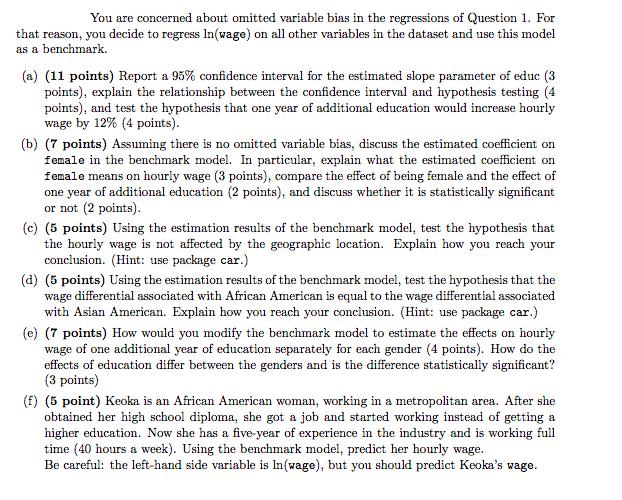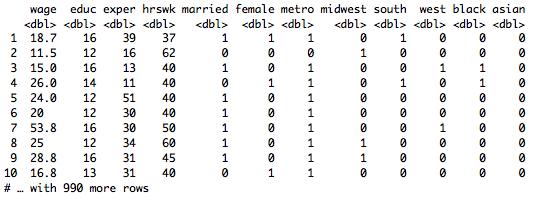Answered step by step
Verified Expert Solution
Question
1 Approved Answer
You are concerned about omitted variable bias in the regressions of Question 1. For that reason, you decide to regress In(wage) on all other


You are concerned about omitted variable bias in the regressions of Question 1. For that reason, you decide to regress In(wage) on all other variables in the dataset and use this model as a benchmark. (a) (11 points) Report a 95% confidence interval for the estimated slope parameter of educ (3 points), explain the relationship between the confidence interval and hypothesis testing (4 points), and test the hypothesis that one year of additional education would increase hourly wage by 12% (4 points). (b) (7 points) Assuming there is no omitted variable bias, discuss the estimated coefficient on female in the benchmark model. In particular, explain what the estimated coefficient on female means on hourly wage (3 points), compare the effect of being female and the effect of one year of additional education (2 points), and discuss whether it is statistically significant or not (2 points). (c) (5 points) Using the estimation results of the benchmark model, test the hypothesis that the hourly wage is not affected by the geographic location. Explain how you reach your conclusion. (Hint: use package car.) (d) (5 points) Using the estimation results of the benchmark model, test the hypothesis that the wage differential associated with African American is equal to the wage differential associated with Asian American. Explain how you reach your conclusion. (Hint: use package car.) (e) (7 points) How would you modify the benchmark model to estimate the effects on hourly wage of one additional year of education separately for each gender (4 points). How do the effects of education differ between the genders and is the difference statistically significant? (3 points) (f) (5 point) Keoka is an African American woman, working in a metropolitan area. After she obtained her high school diploma, she got a job and started working instead of getting a higher education. Now she has a five-year of experience in the industry and is working full time (40 hours a week). Using the benchmark model, predict her hourly wage. Be careful: the left-hand side variable is In (wage), but you should predict Keoka's wage. wage educ exper hrswk married female metro midwest south west black asian 1 18.7 16 39 37 1 1 1 0 0 0 0 2 11.5 12 16 62 0 0 1 0 0 3 15.0 16 13 40 1 1 0 1 0 4 26.0 14 11 40 0 1 0 0 5 24.0 12 51 40 1 1 0 0 6 20 12 30 40 1 1 0 0 7 53.8 16 30 50 1 1 0 8 25 12 34 60 0 9 28.8 16 31 0 10 16.8 13 31 0 # with 990 more rows. 3 45 40 OTTO 1 1 0 0 0 1 0 0 0 TODO 0 0 1 PPPPPT 1 1 1 OTTO 0 0 0 0 1 1 ALICHOOOOO 1 0 1 0 1 0 0 0 0 1 1 0 0 0 0 0 0
Step by Step Solution
★★★★★
3.48 Rating (171 Votes )
There are 3 Steps involved in it
Step: 1
Answer 3 A regresssion of bad behavior on police force will encounter the evil impacts of disposed of variable inclination in light of the fact that there are many determinates of bad behavior at the ...
Get Instant Access to Expert-Tailored Solutions
See step-by-step solutions with expert insights and AI powered tools for academic success
Step: 2

Step: 3

Ace Your Homework with AI
Get the answers you need in no time with our AI-driven, step-by-step assistance
Get Started


